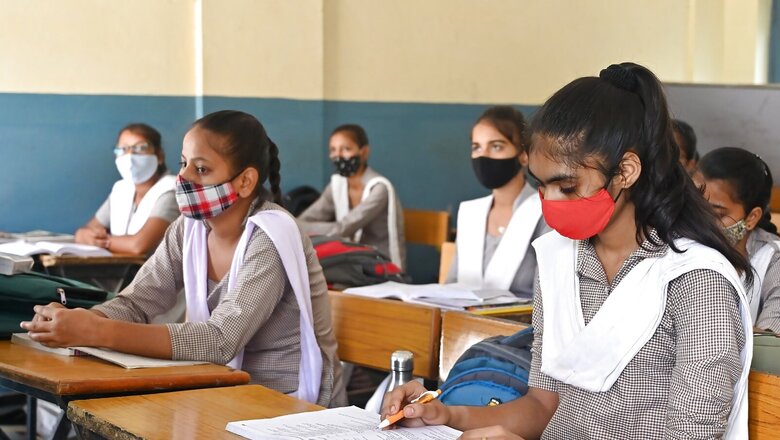
views
On March 11, 2020, the World Health Organization (WHO) declared COVID-19 spread as a pandemic. In the absence of any specific treatment, the focus in the fight against the deadly infection has been on testing and preventing its spread. But with a calamitous second wave hitting India and a third wave looming, vaccination remains the only hope for controlling this disease.
Indeed, vaccine research did progress at “pandemic speed”. And exactly nine months later, on December 11, 2020, the first COVID-19 vaccine—the one by Pfizer-BioNTech—received emergency use authorisation in the US.
Scaling up production of vaccines to meet worldwide demand followed better-than-predicted timelines. However, the limited availability of doses initially necessitated the prioritisation of available vaccines to ensure maximisation of benefits to both individual recipients and the overall population. Accordingly, vaccination was opened on January 16, 2021, for healthcare workers and essential service providers in India. Thereafter, in a phased manner, for senior citizens and those above 45 years. And finally, for all above 18 years.
Here is when India truly stepped up to the challenge. In a matter of months, in spite of the proverbial teething troubles and the humongous challenge of vaccinating a 1.3 billion-strong hugely diverse country, we scaled up production, to some level, imported and in a remarkable display of public acceptance and operational efficiency administered more than 100 crore doses to our population. The second dose uptake is also getting accelerated. This is undoubtedly one of the major reasons why the number of infected cases continues to fall across the country in stark contrast to the situation in some European countries.
However, at least two concerns persist. First, herd immunity will effectively set in when about 70-80 per cent of the population is fully vaccinated. Second, the threat of emerging mutations looms large.
Since a significant number of adults have taken at least one dose of COVID vaccine, it is time we looked at the remainder of the susceptible population.
Children, being a significant part of the population, are naturally a major section that has to be targeted. India has about 40 per cent of its population below 19 years of age. The 2011 Census data reveals that about 35 per cent of the population falls in the age group of 0-14 years and another 10 per cent between 15 and 19 years. More significantly, India has the largest adolescent population in the world, 253 million (25.3 crore), and every fifth person is between 10 and 19 years of age.
Moreover, children are recognised as very subtle vectors of the disease. Since they cannot be easily identified as sources of contagion and subsequently isolated, they represent a big threat to the most vulnerable.
The second wave, which caught us unprepared and overwhelmed the healthcare system, was also notable for an increased virulence, leading to more infections in children and a higher mortality in the younger population as compared to the first wave. In March-April 2021, the number of infections reported among children surged.
Additionally, the number of children with COVID-19 needing hospitalisation and intensive care significantly went up. This has brought children (or an additional 40 per cent of the population) directly under the segment of patients suffering from COVID-19 infection, who would need significant medical care. Moreover, after a prolonged hiatus, schools, especially the higher classes, have reopened, and complete reopening is on the anvil. This undoubtedly paves the way for an immediate vaccination programme for children and adolescents in India.
We have two approved vaccines for this age groups. Zydus vaccine, ZyCoV-D, is approved for use above 12 years of age. It constitutes three doses and uses needle-less technology. COVAXIN by Bharat Biotech is also approved for use above 2 years of age. It constitutes two intra-muscular doses, one month apart.
Higher classes involving adolescents have reopened almost pan India. Adolescents have started attending school now. It is observed that, developmentally, adolescents have a higher risk-taking behaviour and observing COVID-appropriate behaviour at all times may be overlooked, thus exposing the adolescent and their family to a higher risk of infection.
It has also been observed that compared to the severity of illness in children below 12 years, the severity of COVID-19 related illness in adolescents is sometimes similar to what is seen in young adults. Hence, after adult vaccination, it is now a logical step to vaccinate the next group i.e. the adolescents with the available approved vaccination.
While the narrative focuses on vaccination for all children, immediate priority should be given to the more vulnerable adolescent age group with one of the two approved vaccines. As the threat of newer and perhaps deadlier variants hangs like a sword over our necks, vaccinating adolescents as soon as possible will protect this largely unprotected but significantly large population as well as add to the pool of herd immunity. Along with other preventive measures, this seems to be the most appropriate initiative to prevent or at least significantly dent the prospects of a deadly third wave.
Dr Samir H. Dalwai is a consultant developmental behavioural paediatrician and National Treasurer of the Indian Academy of Pediatrics. Dr Jeetendra Gavhane is Professor and Head of Pediatrics at MGM Hospital, Navi Mumbai and President of the Navi Mumbai Academy of Pediatrics. Both are members of Government of Maharashtra Task Force for Pediatric COVID. The views expressed in this article are those of the authors and do not represent the stand of this publication.
Read all the Latest Opinions here

















Comments
0 comment